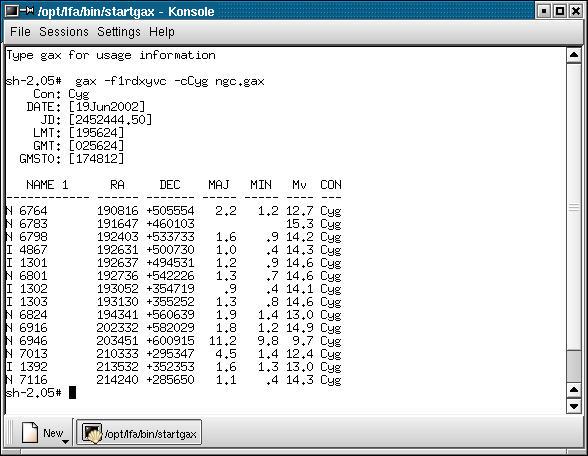

A user-friendly tool to search, sort, and report galaxy information
Version : 1.1
Author(s) : mark anderson (manders1@csc.com)
License : GPL
Website : http://sal.kachinatech.com/Z/4/GAX.html
Installs from Open Source Astronomy for Linux cd 3
Disk space required for installation is 9.38 Mb
After the package is installed it can be accessed using the command
/opt/astro/bin/startgax
A shortcut will be installed in the KDE/GNOME desktop menu system,
as an entry in the Astronomy submenu

At first I tried some "commercial" software like Deep Sky Planner, Hypersky, and even NED online but they weren't very flexible. I also wanted something free that would run on Linux. So I wrote my own.
The user interface uses the standard Unix philosophy, lots of command line switches to control program behavior. This resulted in the main search program, Gax, have quite a few switches and it may be daunting at first site. Never fear though, the manual page has examples that let you see some of the possibilities. Also, typing 'gax' gives a short command synopsis.
If you are using bash then the history feature makes it very easy to try a search, see the results, and then modify the search parameters. Also, piping the output to other utilities is a big plus of GUI-based programs.
The other feature found lacking in the commercial programs was that their output format was determined by the developer, who apparently has different likes and dislikes than me. Gax was designed so that you can specify what the output format looks like to a great extent. I'm sure that it won't please everyone but I figured that I would put this program out and see what kind of feedback, if any, I received.
A major goal was for Gax to be fast. Gax has been used on a Toshiba T4400C laptop with a i486DX2/25Mhz CPU, 20MB RAM and 200MB disk (100MB for Linux) and Gax is fast even on it.
Obviously, the larger the database you have to search the longer it is going to take. Gax has the ability to look through a large database, select certain objects according to your criteria, and create a new database file with only those objects. By creating these subsets, even faster searches are possible.
The ASCII input file that is used to create the Gax database file contains catalog names from the following catalogs: NGC, IC, Messier, UGC, MCG, ESO, CGCG, Arp, Markarian, VV, PGC
I got the data from the NASA National Space Sciences Data Center in the Paturel Galaxy Catalog.
When Gax is compiled, a macro defined in the Makefile specifies which catalog names to keep in the database file. By compiling Gax with fewer catalog names the database file size is further reduced. Out of the box, Gax will maintain names for NGC, IC, and Messier galaxies.
Gax is not done. Some of the documented features related to time are not yet implemented. These are noted on the manual page. At some point I may get around to it unless someone beats me to it.
I hope that you find this program useful. If so, or you don't like it, let me know. Comments, Criticisms and Code (C3) welcomed.